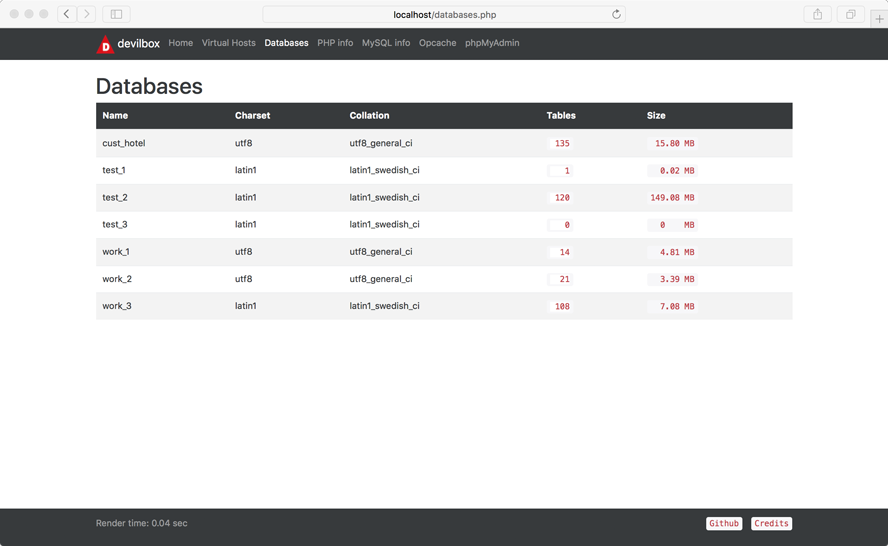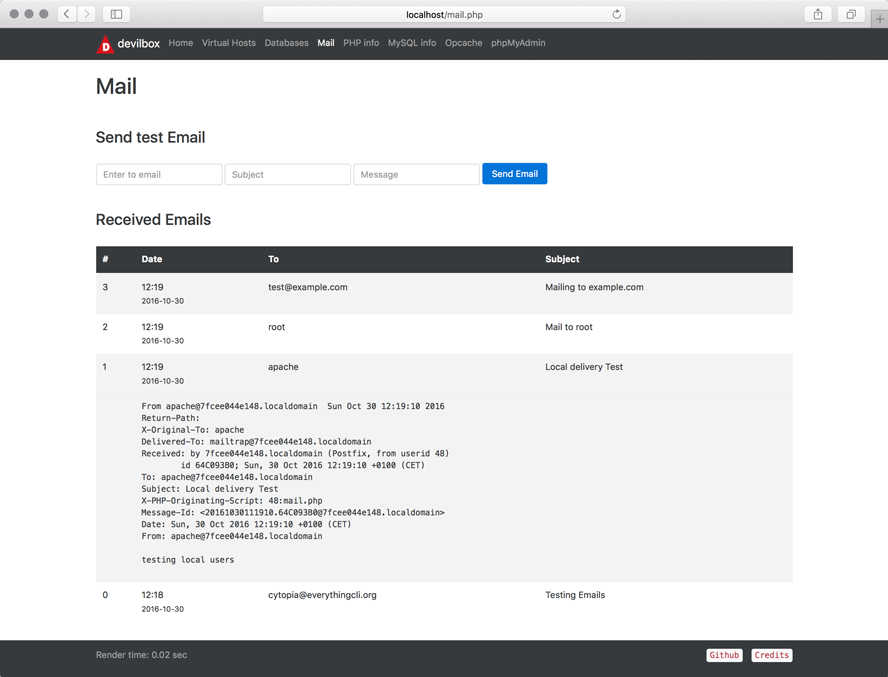
Documentation |
Chat |
Forum |
|---|---|---|
|
|
|
|
| devilbox.readthedocs.io | gitter.im/devilbox | coming soon |
| Linux and MacOS | Windows |
|---|---|
# Get the Devilbox $ git clone https://github.com/cytopia/devilbox # Create docker-compose environment file $ cd devilbox $ cp env-example .env # Edit your configuration $ vim .env # Start all container $ docker-compose up |
1. Clone https://github.com/cytopia/devilbox to C:\devilbox with Git for Windows2. Copy C:\devilbox\env-example to C:\devilbox\.env3. Edit C:\devilbox\.env4. Open a terminal on Windows and type: # Start all container C:\devilbox> docker-compose up |
| Apache | Nginx | PHP | MySQL | MariaDB | Percona | PgSQL | Redis | Memcached | MongoDB |
|---|---|---|---|---|---|---|---|---|---|
| 2.2 | stable | 5.2[1] | 5.5 | 5.5 | 5.5 | 9.1 | 2.8 | 1.4.21 | 2.8 |
| 2.4 | mainline | 5.3 | 5.6 | 10.0 | 5.6 | 9.2 | 3.0 | 1.4.22 | 3.0 |
| 5.4 | 5.7 | 10.1 | 5.7 | 9.3 | 3.2 | 1.4.23 | 3.2 | ||
| 5.5 | 8.0 | 10.2 | 9.4 | 4.0 | 1.4.24 | 3.4 | |||
| 5.6 | 10.3 | 9.5 | ... | 3.5 | |||||
| 7.0 | 9.6 | 1.5.2 | |||||||
| 7.1 | 10.0 | latest | |||||||
| 7.2 | |||||||||
| 7.3 | |||||||||
| 7.4[2] |
| Blackfire | MailHog | RabbitMQ | Solr |
|---|---|---|---|
| 1.8 | v1.0.0 | 3.6 | 5 |
| ... | latest | 3.7 | 6 |
| 1.18.0 | latest | 7 | |
| latest | latest |
| Linux and MacOS | Windows |
|---|---|
host> ./shell.sh devilbox@php-7.0.19 in /shared/httpd $ |
C:\devilbox> shell.bat devilbox@php-7.0.19 in /shared/httpd $ |
| :star: Auto virtual hosts | New virtual hosts are created automatically and instantly whenever you add a project directory. This is done internally via vhost-gen and watcherd. |
| :star: Automated SSL certs | Valid SSL certificates for HTTPS are automatically created for each vhost and signed by the Devilbox CA. |
| :star: Unlimited vhosts | Run as many projects as you need with a single instance of the Devilbox. |
| :star: Custom vhosts | You can overwrite and customise the default applied vhost configuration for every single vhost. |
| :star: Custom domains | Choose whatever development domain you desire: *.loc, *.local, *.dev or use real domains as well: *.example.com |
| :star: Auto DNS | An integrated BIND server is able to create DNS entries automatically for your chosen domains. |
| :star: Custom PHP config | Overwrite any setting for PHP. |
| :star: Custom PHP modules | Load custom PHP modules on the fly. |
| :star: Email catch-all | All outgoing emails are catched and will be presented in the included intranet. |
| :star: Self-validation | Projects and configuration options are validated and marked in the intranet. |
| :star: Xdebug | Xdebug and a full blown PHP-FPM server is ready to serve. |
| :star: Many more | See Documentation for all available features. |
| Adminer | phpMyAdmin | phpRedMin | OpCache GUI | Mail viewer |
| :wrench: awesome-ci | A set of tools for static code analysis:file-cr, file-crlf, file-empty, file-nullbyte-char, file-trailing-newline, file-trailing-single-newline, file-trailing-space, file-utf8, file-utf8-bom, git-conflicts, git-ignored, inline-css, inline-js, regex-grep, regex-perl, syntax-bash, syntax-css, syntax-js, syntax-json, syntax-markdown, syntax-perl, syntax-php, syntax-python, syntax-ruby, syntax-scss, syntax-sh |
| :wrench: git flow | git-flow is a Git extensions to provide high-level repository operations for Vincent Driessen's branching model. |
| :wrench: json lint | jsonlint is a command line linter for JSON files. |
| :wrench: laravel installer | laravel is a command line tool that lets you easily install the Laravel framework. |
| :wrench: linkcheck | linkcheck is a command line tool that searches for URLs in files (optionally limited by extension) and validates their HTTP status code. |
| :wrench: linuxbrew | brew is a MacOS Homenbrew clone for Linux. |
| :wrench: markdownlint | markdownlint is a markdown linter. |
| :wrench: mdl | mdl is a markdown linter. |
| :wrench: phalcon devtools | phalcon is a command line tool that lets you easily install the PhalconPHP framework. |
| :wrench: photon installer | photon is a command line tool that lets you easily install the PhotonCMS. |
| :wrench: php code sniffer | phpcs is a command line tool that tokenizes PHP, JavaScript and CSS files and detects violations of a defined set of coding standards. |
| :wrench: php code beautifier | phpcbf is a command line tool that automatically correct coding standard violations. |
| :wrench: scss-lint | scss-lint is a css/scss linter. |
| :wrench: symfony installer | symfony is a command line tool that lets you easily install the Symfony framework. |
| :wrench: tig | tig is a text-mode interface for git. |
| :wrench: wp-cli | wp is a command line tool that lets you easily install WordPress. |
| :wrench: yamllint | yamllint is a linter for yaml files. |















 > **Documentation:**
> [Available Tools](https://devilbox.readthedocs.io/en/latest/readings/available-tools.html)
#### Available PHP Modules
The Devilbox is a development stack, so it is made sure that a lot of PHP modules are available out of the box in order to work with many different frameworks.
> *amqp, apcu, bcmath, bz2, calendar, Core, ctype, curl, date, dba, dom, enchant, exif, fileinfo, filter, ftp, gd, gettext, gmp, hash, iconv, igbinary, imagick, imap, interbase, intl, json, ldap, libxml, mbstring, mcrypt, memcache, memcached, mongodb, msgpack, mysqli, mysqlnd, openssl, pcntl, pcre, PDO, pdo_dblib, PDO_Firebird, pdo_mysql, pdo_pgsql, pdo_sqlite, pgsql, phalcon, Phar, posix, pspell, rdkafka, readline, recode, redis, Reflection, session, shmop, SimpleXML, snmp, soap, sockets, sodium, SPL, sqlite3, standard, swoole, sysvmsg, sysvsem, sysvshm, tidy, tokenizer, uploadprogress, wddx, xdebug, xml, xmlreader, xmlrpc, xmlwriter, xsl, Zend OPcache, zip, zlib*
PHP modules can be enabled or disabled on demand to reflect the state of your target environment.
> **Documentation:**
> [Enable/disable PHP modules](https://devilbox.readthedocs.io/en/latest/intermediate/enable-disable-php-modules.html)
#### Custom PHP Modules
You can also copy any custom modules into `mod/(php-fpm)-
> **Documentation:**
> [Available Tools](https://devilbox.readthedocs.io/en/latest/readings/available-tools.html)
#### Available PHP Modules
The Devilbox is a development stack, so it is made sure that a lot of PHP modules are available out of the box in order to work with many different frameworks.
> *amqp, apcu, bcmath, bz2, calendar, Core, ctype, curl, date, dba, dom, enchant, exif, fileinfo, filter, ftp, gd, gettext, gmp, hash, iconv, igbinary, imagick, imap, interbase, intl, json, ldap, libxml, mbstring, mcrypt, memcache, memcached, mongodb, msgpack, mysqli, mysqlnd, openssl, pcntl, pcre, PDO, pdo_dblib, PDO_Firebird, pdo_mysql, pdo_pgsql, pdo_sqlite, pgsql, phalcon, Phar, posix, pspell, rdkafka, readline, recode, redis, Reflection, session, shmop, SimpleXML, snmp, soap, sockets, sodium, SPL, sqlite3, standard, swoole, sysvmsg, sysvsem, sysvshm, tidy, tokenizer, uploadprogress, wddx, xdebug, xml, xmlreader, xmlrpc, xmlwriter, xsl, Zend OPcache, zip, zlib*
PHP modules can be enabled or disabled on demand to reflect the state of your target environment.
> **Documentation:**
> [Enable/disable PHP modules](https://devilbox.readthedocs.io/en/latest/intermediate/enable-disable-php-modules.html)
#### Custom PHP Modules
You can also copy any custom modules into `mod/(php-fpm)-














 > **Documentation:**
> **Documentation:**

|

|

|

|


 ## License
[MIT License](LICENSE.md)
Copyright (c) 2016 [cytopia](https://github.com/cytopia)
## License
[MIT License](LICENSE.md)
Copyright (c) 2016 [cytopia](https://github.com/cytopia)